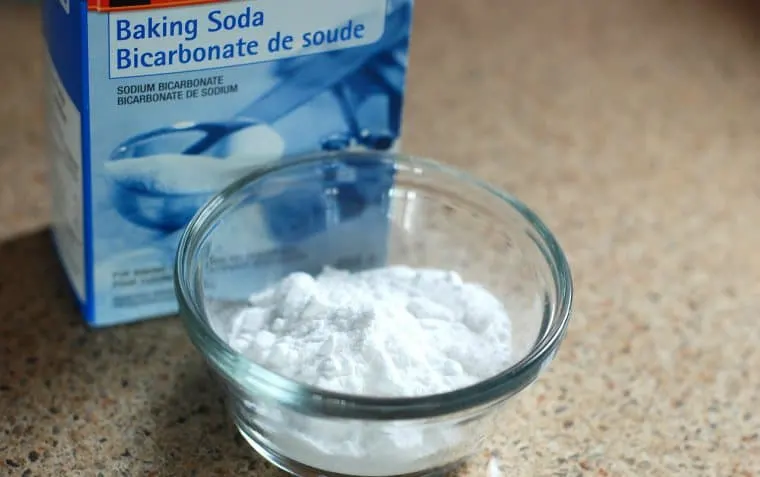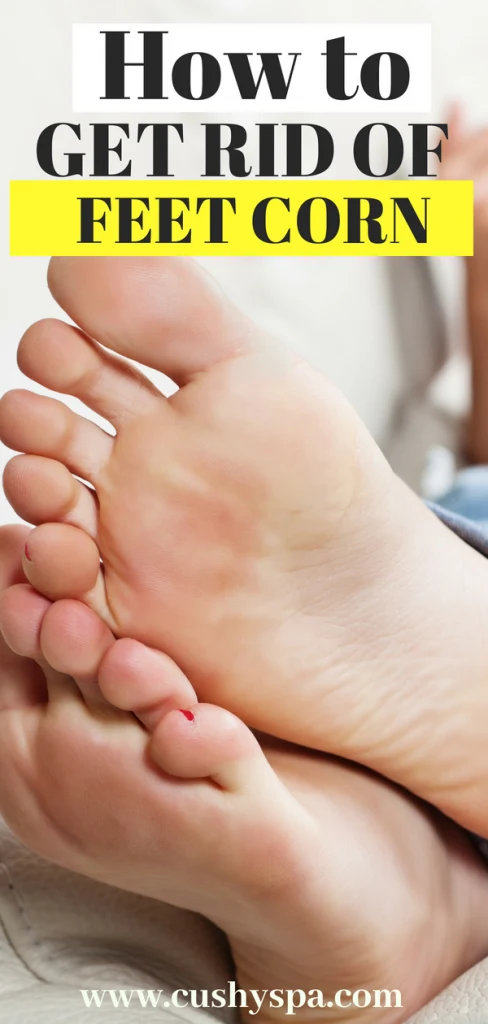
TLC is something we regularly omit to give to our feet. Yet these wonderful inventions are what we take advantage of every day of our lives.
This blog is supported by readers purchasing featured products. When you buy products with my links, I earn a commission at no extra cost to you. Here is my full affiliate disclosure.
Our feet walk many millions of miles over a lifetime and we should really take care of them. So, learn how to get rid of corns on your feet and finally take care of your feet.
What are Corns?
Corns are quite literally all about the thickening of the skin, otherwise known as Hyperkeratosis. There are different types of Corn – a Hard Corn, a Soft Corn, and a Seed Corn.
Hard Corn
A hard corn is a small dense patch of dead skin which has a toughened casing above the surface. It’s usually found on the tops and sides of the toes (especially the little toes); these hard corns have a smaller ‘pack’ of dark skin found in the core.
Soft Corn
A soft corn is reddish in color on the outer edge with a thinner whitish middle surface and is rubbery and tender to touch. These types of corn generally occur between the toes.
Seed Corn
Seed corns are often very painful yet discrete clusters of plug-like circles of skin. They usually form on the weight-bearing heel or ball part of the foot.
Some seed corns occur on the sole (plantar) of the feet, and this is believed to be caused by congested sweat ducts. That’s due to the fact that feet spend most of their time in a moist environment.
Moisture ideal condition for fungoid and bacterial infection breeding. Bacteriological infections commence when germs enter the corn through disruptions in the skin.
These cause the infected skin to discharge fluid or pus. All of these disorders can worsen and make walking unbearable unless they are addressed.

What are Foot Corns Caused By?
Most corns develop due to improper walking, bad posture or wearing incorrect footwear.
How to Spot a Corn?
- Formation of flaky, dry skin.
- A bump forming on the skin of the foot.
- Thickening of skin in a focused area.
- A hardened center developing.
- Most commonly in between toes, on heel or ball of feet or on the outer edge of little toes.
- Varying in color from reddish sore outer zone to off-white or yellow middle area to darkened packed nucleus.
- Maybe tender or throb or prickle.
- May form cracks (fissures) that are often sore.
How to Prevent Corns
Prevention of developing corns is the most understandable and healthiest option, so try not to wear ill-fitting or high-heel shoes. Always wear socks with footwear of all types (including trainers and sandals).
Give feet some ‘breathing space’ and a little TLC (such as foot massage, spa, reflexology). That’s so as they are not continually in a ‘moist’ environment.
Check your posture and ensure your headrests evenly over your upper body with your shoulders drawn back and aligned correctly over your hips.
Relax the shoulders when you walk and keep the chin aligned with the ground. Avoid looking downward as you walk – which creates a tendency to stoop and in turn increases the pressure on your toes.
Check your gait is even and balanced which in turn will result in more equilibria of weight distribution over both feet.
How to Get Rid of Corns on Your Feet
For those of you who already suffer from the manifestation of a Corn let us take a look at some of the curing treatments you can administer in the comfort of your own home.
Please note that if you suffer from disorders of fragile skin or poor circulation (including conditions such as diabetes or peripheral arterial disease) you should consult your doctor.
Medical Treatment
Salicylic-acid is the most commonly used treatment for the curation of Corns. It is a Keratolytic, meaning it dissolves the protein (keratin).
That produces both the corn and the thick conical layer of dead skin which rests atop it.
Over the counter, Salicylic-acid treatments are gentle and safe for most people. Except for conditions such as diabetes and poor circulation who should seek professional advice.
They are used in different forms such as pads, drops, plasters, and applicators. When salicylic-acid is applied to the ‘root’ of the corn it purportedly deadens the top layer of skin cells.
That allows them to then be trimmed or peeled away. Over time, you’ll reduce the protrusion of the corn and give relief to the pressure.
That said there is an abundance of treatments to choose from which you can manage at home but for a more natural acid-free remedy look at the following for inspiration.
Read More: How to Get Rid of Calluses on Feet at Home?
Natural Home Remedies
For those thinking about how to get rid of corns on your feet naturally, here are some natural remedies that might very well help you!
1. Castor Oil and Apple Cider Vinegar

Castor oil has been used for centuries to treat various health problems. This oil can treat pain, inflammation and other infections.
Studies have shown that it kills bacteria and its acidity helps to treat inflammation.
Apple cider, on the other hand, breaks down tough skin with its acids. Kills bacteria and fungi too.
It’s also good at getting rid of smelly feet.
- Fill a basin with hot, soapy water.
- Add one small cup of apple cider vinegar.
- Soaking your foot (or feet) in the water for at least 15 minutes.
- Corns should be softened enough to be filed with a pumice stone (a rough piece of volcanic mineral).
- After filing, rinse away any skin debris and pat dry with a clean towel.
- Dab some castor oil onto the affected area.
- Continue treatment for a week to 10 days or until the full reduction of the corn.
2. Lemon

Before repose, cut a wedge of lemon about an inch long and place over the corn, secure with a plaster or bandage. Cover with a linen or cotton sock.
Continue treatment each night or during meditation/relaxation until the corn dissolves.
Natural lemon acids will break down tough skin and vitamin C will revive your skin by improving collagen production.
It smells great too. Tips on how to get rid of corns on feet naturally can be as simple as this one.
3. Aromatherapy/Essential Oil Massage

Essential oils can do wonders both to your soul and your skin. They constantly prove to us that aromatherapy is powerful and can improve someone’s health significantly.
Many essential oils are highly anti-fungal and anti-bacterial. Therefore, can reduce inflammation.
The aroma they produce helps you to relax relieves stress and lets you stay in a moment for a little bit.
That is always important when taking care of your body.
- Prepare a tincture of carrier oil (almond or grapeseed) with 2-3 drops each of Lavender, Lemon, Eucalyptus and Tea Tree oil and blend together in a glass bottle.
- Soak feet in warm water for 5-10 minutes.
- Pat dry with a soft clean towel.
- Apply the tincture to the hands and rub hands together to develop heat.
- Commence gentle massage to one foot first and then the other.
- Ensure you massage in between toes, around ball and heel of the foot and outer edges.
- Put on fresh clean socks.
- Make time to administer this treatment every 24-36 hours.
4. Epsom Salts

Epsom salt is named after a town in England. It contains magnesium and sulfate.
This salt has anti-bacterial and anti-fungal properties which protect skin from inflammations, infections and treats wounds. Epsom salt promotes magnesium absorption.
Magnesium simply lessens foot discomfort, relaxes your muscles and nerves.
Overall, it helps to prevent the corn from forming the next time and keeps your body happy.
- Place a handful of Epsom salts into a basin of warm water.
- Soak feet for about 10 minutes.
- Once the dead skin has softened, use a pumice stone to gently rub off the top layers.
- Wash feet with clean water to remove dead skin cells.
- Pat dry with a clean towel.
- Rub a thick foot lotion onto your feet or alternatively use basic petroleum jelly based ointment with a couple of drops of aromatherapy essential oil (Eucalyptus, Myrrh, Sandalwood, Lavender).
- Continue treatment each day after a bath or shower.
5. Baking Soda

The crystals in baking soda work as a natural exfoliator, thus making it very good preparation for the reduction of hard skin.
It will clean your skin and get rid of all the odors. Works as good as it sounds.
This treatment is best actioned before going to bed.
- Add three tablespoons of baking soda to a tub filled with warm water. Stir thoroughly and soak your feet in it for at least 10 minutes. Wash your feet and scrub the softened skin with a pumice stone
- Massage the Corn(s) for a few minutes with a paste prepared with three parts baking soda and one part water.
- Rinse off the paste and remove any dead skin cells by rubbing gently with a pumice stone
- Pat dry with a clean towel
- Put clean soft padded socks on to help retain overnight heat for optimum oil absorption.
General Advice
How to get rid of corns on your feet? Simply follow any mixes of these remedies once daily until your feet look healthy again.
None of the procedures should cause you unpleasant pain or discomfort. Therefore, make sure you’re not overdoing it.
As mentioned before, it’s best to go and consult your doctor in case the corn doesn’t want to go away. It’s a good idea to do it before any treatment too.
Many doctors will recommend natural remedies if the problem is not serious.
Conclusion
Now that you know how to get rid of corns on your feet, go and make most out of this article. Try different natural remedies and see what works best for you.
In case you have any questions, comment below. Now have a nice and take care!
Sources:
